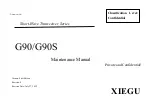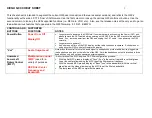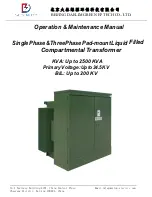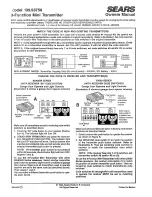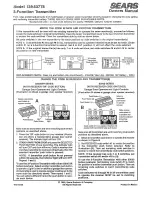
NOVUS AUTOMATION
2/3
The TxConfig screen in shown in Fig. 3.
Fig. 3 – TxConfig main screen
The fields in the screen mean:
1.
Input Sensor: Select the sensor to be used. See Table 1.
2.
Measuring Range: Define the transmitter measurement range.
Range Lower Limit: temperature desired for a 4 mA current.
Range Upper Limit: temperature desired for a 20 mA current.
When the Lower Limit is set with a value greater than the Upper
Limit value of the output current operates from 20 to 4 mA (the
current decreases as the temperature increases).
Note: The values chosen can not exceed the Sensor Range shown
in this same field, and also may not establish a range with width
(span) smaller than the Min. Range indicated later in this same field.
See Table 1 of this guideline.
3.
Sensor Failure: It establishes the output behavior, when the transmitter
indicates a failure:
Minimum: output current goes to 3.8 mA (down-scale), typically used for
refrigeration.
Maximum: output current goes to 20.5 mA (up-scale), typically used for
heating.
4.
Device Information: This field contains the data identifying the
transmitter. This information must be submitted to the manufacturer for
any queries.
5.
Zero Correction: It corrects small deviations presented in the transmitter
outlet, for example, when the sensor is replaced.
6.
Send Configuration: It applies the new setup. Once sent, the setup will
be immediately adopted by the transmitter.
7.
Read Configuration: Reads the current setup in the transmitter
connected. The screen now presents the current setup that may be
changed by the user.
Note: The factory default configuration is:
•
Sensor Pt100, range 0 to 100 °C, 0 °C of zero correction.
•
Output at maximum for the sensor failures.
Upon purchase order, the user can define a specific setup.
MECHANICAL INSTALLATION
The TxIsoPack transmitter is suitable to be installed in heads. Vibrations,
moisture and extreme temperatures, electro-magnetic interference, high
voltage and other interferences can permanently damage the unit, and could
cause error in the measured value.
DIMENSIONS:
Fig. 4 – Transmitter dimensions
ELECTRICAL INSTALLATION
Polyamide enclosure.
Section of the cable used: 0.14 to 1.5 mm².
Recommended torque in the terminal: 0.8 Nm.
RECOMMENDATIONS FOR INSTALLATION
•
Sensor signals conductors must go through the plant system separate
from power leads (loop), if possible in grounded conduits.
•
The instruments must be powered from the instrumentation power supply
circuit.
•
In control and monitoring applications is essential to consider what can
happen when any part of the system fails.
•
It is recommended the use of suppressors in contact coils, solenoids and
any inductive load.
•
Use compensation cables in the connections using thermocouples.
ELECTRICAL CONNECTIONS
The figures below show the electrical connections required. The terminals 3, 4,
5 and 6 are dedicated to the sensor connection. LOAD represents the 4-20 mA
current measuring device (indicator, controller, recorder, etc.)
PT100 2-WIRES
Note: When the Pt100 2-wires the terminals 3 and 4 must be interconnected,
according to the figure below.
Fig. 5 – Transmitter electrical connections (Pt100 2-wires)




